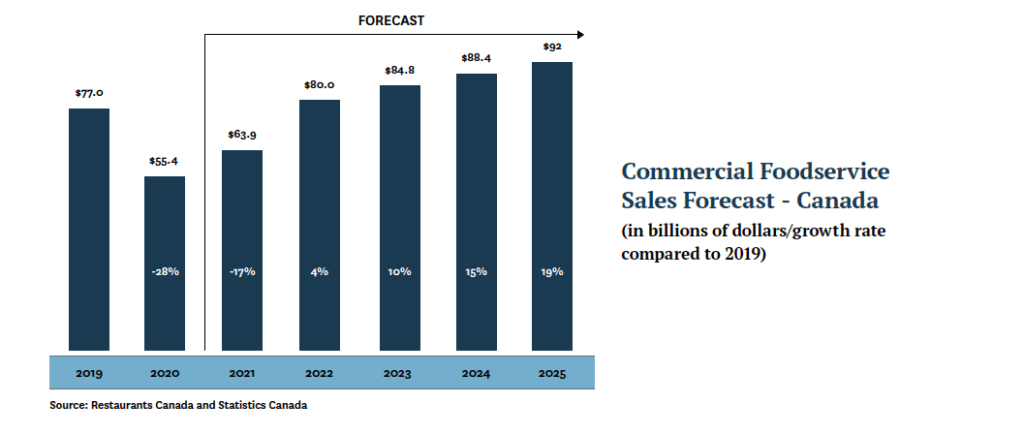Foodservice Facts 2021: Putting the Pieces Back Together
For the last two years, pulling together our annual Foodservice Facts report has been challenging, tricky, and tough. The COVID-19 pandemic shattered Canada’s foodservice industry, inflicting a devastating impact across the entire foodservice landscape. The effects rocked every corner: from manufacturers, suppliers, distributors, restaurants, and bars, to hundreds of thousands of employees, as foodservice sales plummeted to their lowest level in more than two decades in April 2020. Since then, it’s been a volatile time with more than 10,000 foodservice establishments permanently closing their doors.
Sales were expected to improve in the first half of 2021, but a severe third wave hit foodservice operators hard once again, resulting in a lengthy shutdown of on-premises dining across many parts of Canada in April and May. As the foodservice industry shifts into recovery mode and Canadians feel more comfortable returning to restaurants, the expectation is the economy will continue to gradually reopen in the second half of 2021.
Despite the setbacks of the last two years, hope is on the horizon. Canada has one of the highest vaccination rates in the world, with almost 75 per cent of Canadians (12 and older) being fully vaccinated at the time of writing.
As a result, annual commercial foodservice sales are now expected to increase to $63.9 billion in 2021, which is an upward revision from our previous forecast that called for sales of $61.1 billion. By the fourth quarter of 2021, quick-service restaurants are forecast to return to pre-COVID levels. Still, total commercial foodservice sales in Canada will remain 17% below pre-pandemic levels due to the weak first half of 2021.
The outlook for 2022 is even more encouraging as overall foodservice sales in Canada are forecast to grow to nearly $80 billion compared to the previous forecast of $75.9 billion. As a result, foodservice sales expected are to be 3.8%above pre-pandemic levels. The upward adjustment in the forecast reflects several favourable developments, including the aforementioned recent surge in vaccinations in Canada, combined with stronger-than-expected growth in consumer spending. Full-service restaurants are now expected to return to pre-pandemic levels in the second quarter of 2022. By the end of 2022, real per capita foodservice spending at quick- and full-service restaurants is expected to reach 97% of pre-pandemic levels, while caterers will be at 94% of pre-pandemic levels. Drinking places, however, are expected to be at only 85% of pre-pandemic levels by the end of 2022, due to unit closures and consumer hesitancy to return to bars, taverns, and nightclubs.

While the economic outlook has improved significantly and we’ve seen positive developments that will lead to stronger commercial foodservice sales in Canada, Restaurants Canada remains cautious when it comes to the timing of the recovery. Some aspects of foodservice sales will continue to be restrained, including weak foodservice spending by international visitors(which accounted for 4 per cent of foodservice sales in 2019) and business travel and meals. Lastly, there still remains uncertainty about the virus itself.
The fourth wave and potential for more stringent containment measures could put a halt to the reopening of the economy. Even with a reopening, it will take time for the foodservice industry to bounce back. Currently, the economy is going through a K-shaped recovery — some sectors are on an upward swing while others are in decline. Of the four largest private-sector employers before the pandemic, retail, construction and manufacturing are at or near pre-COVID-19 levels. Foodservice, however, has a much longer road to recovery.
So what does recovery look like for the foodservice industry? We see it much like a puzzle, with loops and sockets, tabs and slots, all in fragments which our industry is urgently trying to piece together to understand what the whole picture looks like. We are trying to figure out what piece fits where navigating each bit, again and again, to decipher how everything works together in a post-pandemic world, realizing we may be missing pieces as the industry has changed and that somehow we need to now fill those holes and gaps.
In order to successfully build the puzzle, it’s important that recovery is addressed from two main viewpoints—both as a foodservice business owner and also through the lens of the customers—not only thinking about what restauranteurs can do but also what the customer wants.
Many businesses are facing labour shortages, higher costs and higher debts. Menu prices are forecast to rise by 2.9 per cent in 2021, followed by a 3.7 per cent increase in 2022. Delivery, which gained traction throughout the pandemic, will continue to be a lifeline, and restaurants need to focus on how to make this a piece of their reopening puzzle—how to continue bringing service and food to customers in ways that make them comfortable. Throughout the pandemic, restaurants have constantly pivoted by paring down menus, creating meal boxes, offering groceries within their environments, taking the opportunity to clean their spaces, and ready staff while preparing for customers to enter their doors once again.
The good news is that Canadians do want to dine out. A survey of Canadians in May 2021 found that 89 per cent of Canadians are looking forward to going out to a restaurant with friends and family again. They are looking for health and safety, speed and convenience and a meaningful experience.

Recovery is often seen as a period to heal oneself, and that is what our industry needs to do—to look inward to create that positive change. The only certainty we can expect in the future is to get comfortable with being uncomfortable. Through facing that discomfort and unease comes growth. Change is good. It is messy and frustrating, exhausting and at times overwhelming, but it is necessary. While our patios may have filled up and we can see a small pinhole of light at the end of the tunnel, it is not the time to relax or fall into old habits. We have survived the storm and now it’s time to learn from it. It’s time to cautiously, yet optimistically, finish the puzzle.
GET YOUR COPY NOW!
This year’s Foodservice Facts is packed with a variety of industry experts on what key opportunities exist to keep your business running during these turbulent times. As Canada’s most trusted foodservice industry research and insights guide, this special edition looks at how foodservice operators are adapting to survive the unprecedented impact of COVID-19. Click here to purchase the full report.
Fill out the form below to get a free preview of Foodservice Facts 2021 Report: [hubspot portal=”2429874″ id=”becef8d9-aa64-4d2f-95da-398f9ef8b5fc” type=”form”]









